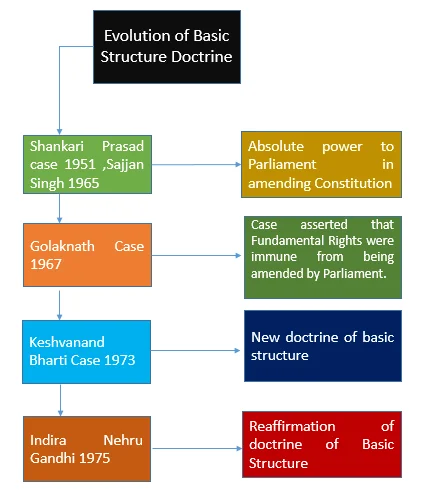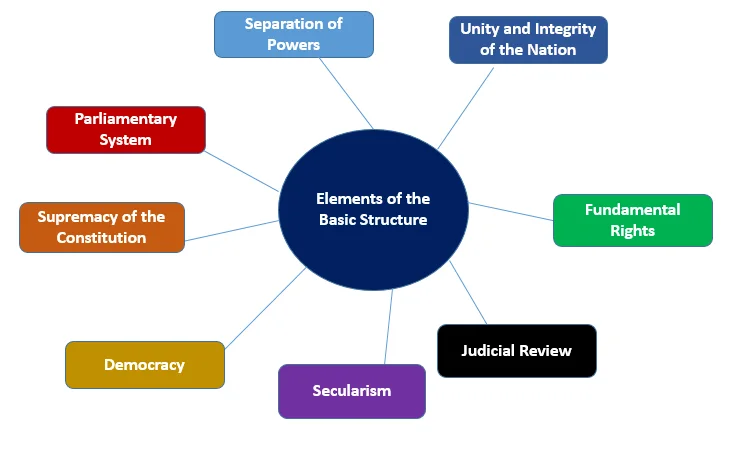The Doctrine of Basic Structure has significantly influenced India’s constitutional jurisprudence. Introduced by the Supreme Court in the 1973 Kesavananda Bharati case, it asserts that certain core elements of the Constitution are beyond Parliament’s amending power. This doctrine, although not explicitly mentioned in the Constitution, ensures the protection of fundamental principles and values. Its evolution through key cases has shaped India’s legal and political framework.
Emergence of the Basic Structure
Emergence of the Doctrine: The Doctrine of Basic Structure has played a pivotal role in shaping the constitutional jurisprudence in India.
- It emerged through judicial interpretation stating that certain aspects of the Indian Constitution are beyond Parliament’s amending power.
- Establishment and Impact: It was established as a key principle by the Supreme Court of India and has since had a profound impact on the country’s legal and political landscape.
- Recognition in Kesavananda Bharati Case: While the term “Basic Structure” is not mentioned in the Constitution, it gained recognition in the 1973 Kesavananda Bharati case for the first time.

Enroll now for UPSC Online Course
Shankari Prasad Case (1951)
- Challenge to First Amendment Act (1951): The Supreme Court ruled that the power of Parliament to amend the Constitution under Article 368 includes the power to amend Fundamental Rights.
- Interpretation of ‘Law’ in Article 13: The term ‘law’ in Article 13 encompasses only ordinary laws, not constitutional amendment acts (constituent laws).
- Parliament’s Power over Fundamental Rights: Therefore, Parliament can abridge or take away any Fundamental Right by enacting a constitutional amendment act, and such a law will not be void under Article 13.
Sajjan Singh Case (1964)
-
- Re-Affirmation of Previous Stand: In the Sajjan Singh case (1964), the Supreme Court reaffirmed its previous position that a constitutional amendment act made under Article 368 is not a law within the meaning of Article 13.
- Fundamental Rights can be amended through such acts.
Golak Nath Case (1967)
- Reversal of Previous Stand: In the Golak Nath case (1967), the Supreme Court reversed its earlier stand.
- It ruled that Fundamental Rights have a ‘transcendental and immutable’ position, and therefore, Parliament cannot abridge or take away any of these rights.
- Constitutional Amendment Act: A constitutional amendment act is also considered a law within the meaning of Article 13 and could be void for violating Fundamental Rights.
Parliament’s Reaction: 24th Amendment Act (1971)
- In response to the Golak Nath case (1967), Parliament enacted the 24th Amendment Act (1971), amending Articles 13 and 368.
- Parliament’s Authority Under Article 368: It declared that Parliament has the power to abridge or take away Fundamental Rights under Article 368, and such an act will not be considered a law within the meaning of Article 13.
Kesavananda Bharati Case (1973)
- Reversal of Golak Nath Judgment: In the Kesavananda Bharati case (1973), the Supreme Court overruled its decision in the Golak Nath case.
- It upheld the validity of the 24th Amendment Act (1971) and stated that Parliament is empowered to abridge or take away Fundamental Rights.
- Introduction of the Basic Structure Doctrine: However, the court introduced the doctrine of the ‘Basic Structure,’ which limits Parliament’s amending power.
- Parliament cannot abridge or take away a Fundamental Right that forms a part of the ‘Basic Structure’ of the Constitution.
Indira Nehru Gandhi Case (1975)
- Application of ‘Basic Structure’: In the Indira Nehru Gandhi case (1975), the Supreme Court invalidated a provision of the 39th Amendment Act (1975) that kept election disputes involving the Prime Minister and the Speaker of Lok Sabha outside the jurisdiction of all courts.
- Limitation on Parliament’s Amending Power: The court held that this provision was beyond Parliament’s amending power as it affected the Basic Structure of the Constitution.
42nd Amendment Act (1976)
- Parliament’s Response: Parliament reacted to the doctrine of ‘Basic Structure’ by enacting the 42nd Amendment Act (1976), which declared that there is no limitation on the constituent power of Parliament, and no amendment can be questioned in any court on any ground, including contravening Fundamental Rights.
Minerva Mills Case (1980)
- Invalidation of Judicial Review Exclusion: The Supreme Court invalidated the provision of the 42nd Amendment Act (1976) that excluded judicial review, which is considered a ‘basic feature’ of the Constitution.
- Reiteration of Limited Amending Power: The court reiterated that Parliament’s amending power is limited, and it cannot expand that power into an absolute one.
- Preservation of the Basic Structure Doctrine: The ‘Basic Structure’ doctrine remains in place, and Parliament cannot alter the ‘Basic Structure’ of the Constitution.
Elements of the Basic Structure
Judicial Identification: The elements of the Basic Structure have not been explicitly enumerated in the Constitution itself, but they have been identified through various judicial pronouncements.
- Core Principles and Values: These elements represent the core principles and values that are considered fundamental and unalterable.
Some of the key elements include:

- Supremacy of the Constitution: The Constitution is the supreme law of the land, and all laws, including constitutional amendments, must conform to it.
- This principle ensures that the Constitution remains the ultimate source of authority.
- Democracy: The democratic principles, including free and fair elections and the right to equality, are integral components of the Basic Structure.
- These ensure that India remains a democratic republic.
- Secularism: The Preamble of the Constitution declares India as a secular state.
- In SR Bommai case (1994), SC termed secularism as part of Basic Structure.
- Federalism: The distribution of powers between the central and state governments, as enshrined in the Constitution, is considered an essential feature of the Basic Structure.
- It preserves the federal nature of the Indian polity.
- Judicial Review: The power of the judiciary to review laws and executive actions to ensure they are in line with the Constitution is a crucial element.
- It safeguards the rights and liberties of citizens.
- Essence of Fundamental Rights: The protection of Fundamental Rights, such as the right to equality, freedom of speech, and personal liberty, is an integral part of the Basic Structure.
- These rights are considered sacrosanct.
- Rule of Law: The principle that all individuals, including the government, are subject to the law is a fundamental element.
- It ensures that the government acts within the boundaries of the Constitution.
- Separation of Powers: The division of powers between the three branches of government (legislature, executive, and judiciary) is a fundamental feature that prevents the concentration of power.
- Unity and Integrity of the Nation: The commitment to preserving the unity and integrity of the country is considered part of the Basic Structure.
- It upholds the territorial integrity of India.
- Parliamentary System: The democratic Parliamentary System of government, with checks and balances, is considered an essential element.
- It ensures responsible and accountable governance.
What is Judicial Review?
|
Enroll now for UPSC Online Course
| Must Read | |
| Current Affairs | Editorial Analysis |
| Upsc Notes | Upsc Blogs |
| NCERT Notes | Free Main Answer Writing |
Conclusion
The Doctrine of Basic Structure safeguards the core principles of the Indian Constitution, preventing Parliament from altering its essential features.
- Through landmark judgments, the Supreme Court has defined these unchangeable elements, ensuring the Constitution’s supremacy, democracy, and fundamental rights.
- This doctrine maintains a balance of power among the branches of government, preserving India’s democratic and constitutional integrity. Its enduring impact continues to shape India’s legal landscape.
Sign up for the PWOnlyIAS Online Course by Physics Wallah and start your journey to IAS success today!
| Related Articles | |
| Supreme Court | Fundamental Rights (Article 12-35) |
| Article 368’s Role and the Constitutional Amendment Procedure | ESSENCE OF INDIAN CONSTITUTION: BASIC STRUCTURE DOCTRINE UNBOUND |

 GS Foundation
GS Foundation Optional Course
Optional Course Combo Courses
Combo Courses Degree Program
Degree Program









